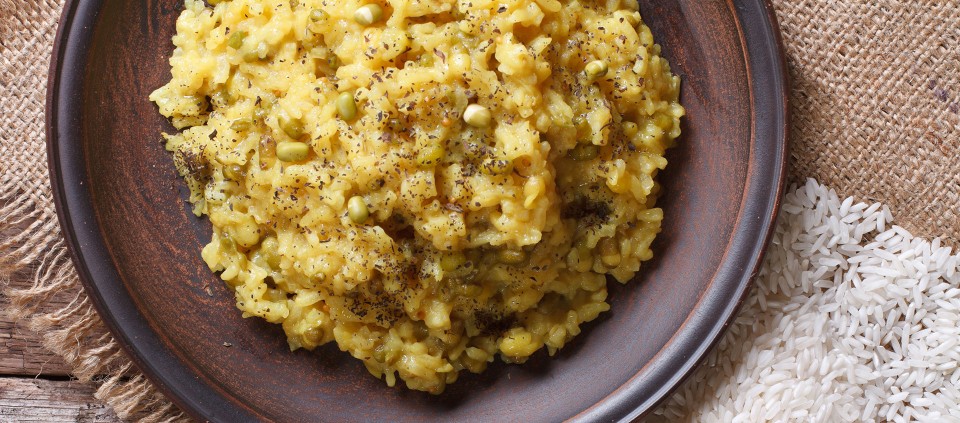Kripalu Recipe: Nourishing Kitchari

Kitchari, traditionally made of yellow mung dal beans and basmati rice, along with digestive spices and ghee, is considered a cleansing and detoxifying food in Ayurveda. There is plenty of Ayurvedic wisdom to support kitchari’s healing properties.
In Ayurveda, sound digestion is paramount to health and wellness. If we’re not digesting, assimilating, and eliminating our food properly, disease can set in. Kitchari is offered as a mono-nutrient fast in Ayurveda, giving our digestive system a much-needed break from having to process all different kinds of food day in and day out. It’s considered cleansing in the sense that it allows the digestive system to rest, and it’s also nutritious and easily assimilated by the tissues.
Mung dal beans are high in protein and carbohydrates, offering satiety and energy. Protein is important for keeping the blood sugar, and therefore the mood, stable. Basmati rice is easy to digest, and the spice "churna," or mixture, sparks our agni, or digestive fire. The ghee (or oil) lubricates the system and further aids in digestion. You can add seasonal vegetables to the recipe for variety and to boost the vitamin and mineral content of the dish.
Kitchari travels well—put it in a thermos and bring it to work for lunch, or, if you make a big pot of it, use it the next day for breakfast, lunch, and/or dinner.
Here’s how to make the perfect kitchari, with vegan and grain-free variations as well as options for all three doshas: kapha (earth and water), pitta (fire and water), and vata (air and ether).
Basic Kitchari Recipe
2 cups yellow mung dal beans
2 tablespoons ghee or organic sesame oil
2 teaspoons each black mustard seeds, cumin seeds, turmeric powder, and black pepper
2 bay leaves
1 teaspoon each cumin powder, coriander powder, fennel seeds, fenugreek seeds (cinnamon optional in winter)
1 cup white basmati rice
3 green cardamom pods
2 cloves
2–5 cups of chopped, organic, seasonal vegetables such as spinach, carrots, celery, kale, and bok choy (avoid nightshades)
1 cup chopped fresh cilantro (optional)
Rinse the mung dal beans and strain them five times, or until the water runs clear. Heat the ghee or oil in a large pot. Add all the seeds and toast until the mustard seeds pop. Add the bay leaves and powdered spices, and mix together. Stir in the rice and beans. Add eight cups of water, cardamom pods, cloves, and chopped vegetables. Bring to a boil and reduce to a simmer. Cook at least one hour, or until the beans and rice are soft and the kitchari has a porridge-like consistency. Serve warm with fresh cilantro on top, if desired.
Variations
Tweak the recipe according to your dosha, or to make it gluten or dairy free. (Don't know your dosha yet? Take our quiz.)
Kapha
- Omit the ghee or oil, and instead soften the spices by cooking in two inches of water before adding the rice and dal.
- Use quinoa, millet, or amaranth instead of rice.
- Add about ½ inch of chopped, fresh ginger to the oil when cooking the spices.
- Add a pinch of cayenne while cooking.
- Use half the amount of ghee or oil.
- Best veggies for a kapha variation are leafy greens, Brussels sprouts, cauliflower, asparagus, and celery.
Pitta
- Use half the amount of mustard seeds and black pepper, or omit mustard seeds altogether.
- Replace ghee with coconut oil.
- Best veggies for a pitta variation are leafy greens, broccoli, cauliflower, asparagus, zucchini, and carrots.
Vata
- Use twice the amount of ghee or oil.
- Add a pinch of cayenne while cooking.
- Add about ½ inch of chopped fresh ginger to the oil when cooking the spices.
- Use quinoa instead of rice to increase the protein content.
- Use double the amount of rice.
- Best veggies for a vata variation are carrots, zucchini, peas, sweet potatoes, and asparagus.
Vegan
- Use oil rather than ghee.
Grain-free
- Omit the rice and instead chop half a head of cauliflower in a food processor until it reaches the consistency of rice. Toast the mixture in a pan, in 1 tablespoon of ghee or sesame oil. Add after the mung dal beans have cooked.
- Use two cups less water.
Alternative Grains
- Use quinoa, amaranth, or millet instead of rice.
If you’re new to some of the ingredients in this recipe, ask your local natural grocer to help you locate them. The spices and grains are typically sold in the bulk section and/or prepackaged; the mung dal beans and ghee can usually be found in the International Foods aisle—or make your own ghee.
For a mini-detox, eat kitchari for all your meals for a day or two—or simply enjoy it as part of a healthy, delicious, whole-foods diet.
